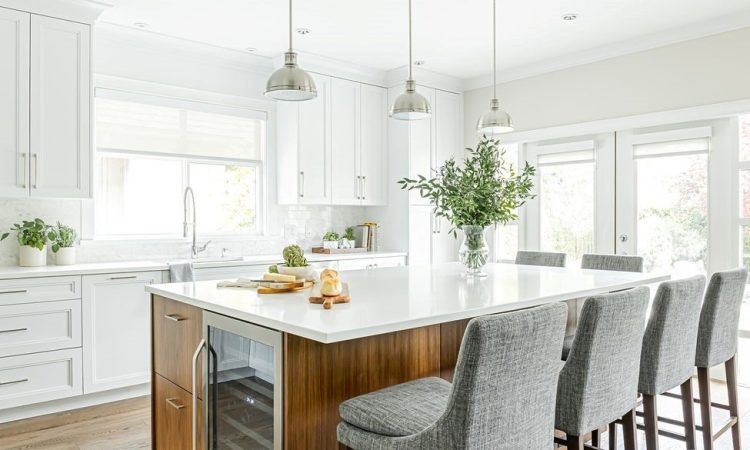The kitchen is often considered the heart of the home, where culinary magic happens, and families gather to create memories. A well-designed kitchen island can elevate this space from simply functional to a true centerpiece of your home. Whether you’re planning a complete kitchen remodel or looking for ways to enhance your current setup, a kitchen island offers a versatile and stylish solution. Let’s explore the benefits, design considerations, and creative ideas to help you make the most of your kitchen island.
Why Add a Kitchen Island?
1. Increased Counter Space
One of the primary reasons homeowners add a kitchen island is to gain additional counter space. This is especially beneficial for meal preparation, providing ample room for chopping, mixing, and assembling ingredients without cluttering your main countertops.
2. Extra Storage Solutions
Kitchen islands can be equipped with various storage options such as cabinets, drawers, and open shelving. This helps keep your kitchen organized by providing a dedicated space for utensils, pots, pans, and even small appliances.
3. Casual Dining and Social Hub
A kitchen island can double as a casual dining area, perfect for quick breakfasts, snacks, or even a full meal. It also serves as a social hub where family and friends can gather, making it a focal point for entertaining guests.
4. Enhanced Functionality
By integrating appliances such as a sink, dishwasher, or cooktop into your island, you can streamline your cooking process. This can create a more efficient work triangle and improve the overall workflow in your kitchen.
5. Added Resale Value
A well-designed kitchen island can increase the appeal of your home and potentially boost its resale value. Homebuyers often view a kitchen island as a desirable feature, making your property stand out in the market.
Design Considerations for Your Kitchen Island
1. Space and Layout
Before adding an island, measure your kitchen to ensure there’s enough space for one. A good rule of thumb is to allow at least 36 to 48 inches of clearance around the island for easy movement and access.
2. Purpose and Functionality
Determine the primary purpose of your island. Will it be used mainly for meal prep, dining, or as a storage solution? This will influence its design, size, and features. For example, if you plan to install a sink or cooktop, ensure there’s adequate plumbing and ventilation.
3. Style and Aesthetics
Choose a design that complements your kitchen’s overall style. Whether you prefer a modern, sleek look with a waterfall countertop or a rustic charm with a butcher block top, ensure the island blends seamlessly with your kitchen decor.
4. Materials and Finishes
Select durable and easy-to-maintain materials for your island’s surface. Popular choices include granite, quartz, and stainless steel for their durability and resistance to stains and scratches. For a more budget-friendly option, laminate and butcher block are also great choices.
5. Lighting and Seating
Proper lighting is crucial for functionality and ambiance. Consider pendant lights to illuminate your island and create a focal point. If you’re adding seating, ensure there’s enough legroom and that the stools or chairs complement the island’s design.
Creative Kitchen Island Ideas
1. Multi-Level Islands
A multi-level island offers a dynamic look and serves multiple functions. The higher level can be used for dining or a breakfast bar, while the lower level provides ample space for meal prep and cooking.
2. Portable Kitchen Islands
For smaller kitchens or those who prefer flexibility, a portable island on wheels can be a great option. It provides additional workspace when needed and can be moved aside to create more room when not in use.
3. Double-Duty Islands
Maximize your island’s functionality by integrating appliances such as a wine cooler, microwave, or mini fridge. This makes it a convenient all-in-one station for cooking, dining, and entertaining.
4. Open Shelving
Incorporate open shelving into your island design for a contemporary look. This provides easy access to frequently used items and allows you to display decorative pieces, adding personality to your kitchen.
5. Bold Color Accents
Make a statement with a bold-colored island. Whether you opt for a vibrant blue, rich green, or sleek black, a pop of color can add a touch of personality and set your kitchen island apart from the rest of the room.
Conclusion
A kitchen island is more than just an additional countertop; it’s a multifunctional centerpiece that enhances the beauty and functionality of your kitchen. By carefully considering its design, layout, and purpose, you can create a space that not only meets your practical needs but also adds value and style to your home. Whether you’re looking to increase your cooking space, add storage, or create a gathering spot, a well-designed kitchen island can transform your kitchen into a more inviting and efficient space.
